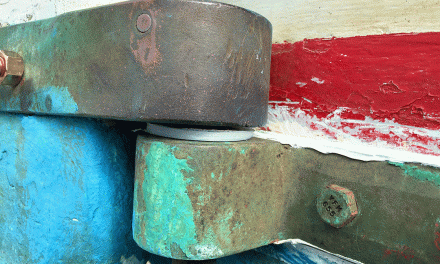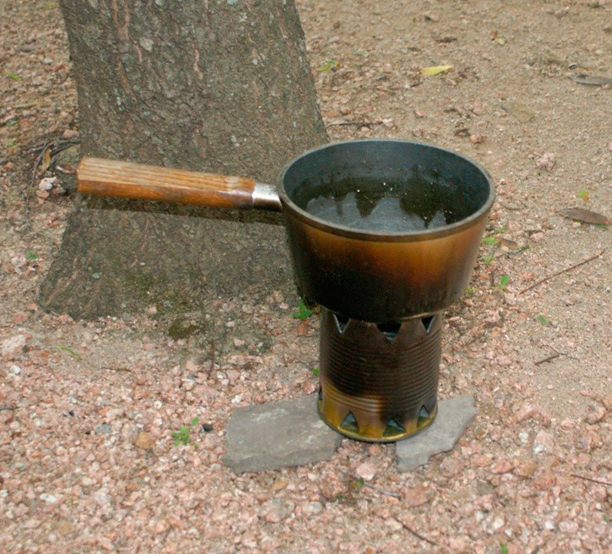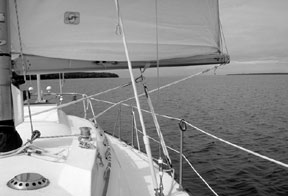Top designer Ted Brewer explains stability and how it affects safety and speed
The speed of a sailing yacht in any given wind is determined, to a large extent, by the amount of sail she can carry. In heavier weather, that sail area is governed by the ability of the hull to remain on its feet; in other words, her stability. In extreme weather conditions, of course, the vessel’s stability also determines her ability to recover from a knockdown, and thus it can be a major contributor to safety.
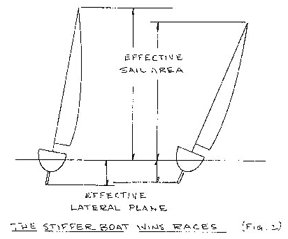
Consider the advantages of a “stiff” or “powerful” sailboat beating to windward in a good breeze. The heel angle of the stiff hull will be less than that of a tender sister, so the sails will present greater effective area to the wind, and the boat will move faster as a result. Also, the lateral plane under water will be more upright, so it will be working to its maximum potential, and the boat will be making less leeway and perhaps pointing a degree or two higher as well. The sailboat that is making better speed, pointing higher, and making less leeway than the competition is bound to be a winner (see Fig. 1).
Stability, in essence, can be defined as the tendency of a vessel to return to an upright condition after it is inclined by external forces: wind, seas, weight shifts, and so on. The inclination can be athwartships or fore-and-aft, of course, but we’ll concentrate on athwartship stability as it is the prime factor in both the power to carry sail and the safety of the craft.
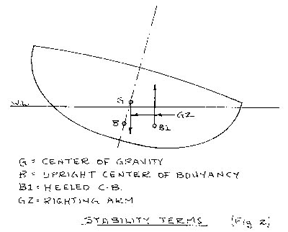
The drawing (Fig. 2) shows the basics of athwartship stability: a boat heeled from her normal upright waterline condition to a heeled waterline with no change in her displacement. The upward thrust of buoyancy always acts vertically to the waterline but now it is acting vertically to the heeled waterline. The shape of the hull moves this buoyant upward thrust from its original centerline position (B) to a point outboard (B1), where it exerts an upward force vertical to the heeled waterline and equal to the displacement of the boat.
The righting lever
The center of gravity (G), barring unforeseen circumstances, does not change position as the boat heels and remains on the centerline, acting downward through the heeled waterline. The horizontal distance from G to a vertical line drawn through B1 is termed the righting arm, or righting lever, (GZ). So with the buoyancy of the hull acting upward through B1 and the weight of the hull acting downward through G, we have a force, or couple, tending to return the boat to its upright position. This force is known as the righting moment and is equal to the vessel’s displacement times the length of the righting arm (Disp. x GZ).
To illustrate, if our boat weighed (displaced) 1,000 pounds and the GZ was 1.75 feet long, the righting moment would be 1,000 x 1.75 = 1,750 foot-pounds. It would take that much force of wind on the sails to heel the boat to that angle or, if no sails were set, it would require the equivalent in weight shift Ñ 500 pounds of crew or other weight moved 3.5 feet to one side.
To sum up, the stability of the boat is directly related to two factors: her displacement, and the length of the righting arm. The heavier the displacement and/or the longer the righting arm, the greater the stability. In turn, the length of the righting arm depends on the location of the center of gravity (CG) and the location of the heeled center of buoyancy (CB). The lower the CG, the longer the righting arm. The further outboard the heeled CB, the longer the righting arm. It’s that simple.
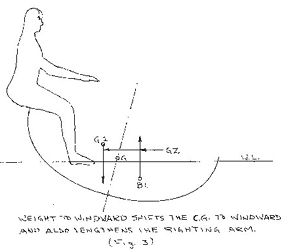
However, a very stable vessel may be uncomfortable in a seaway, as it can develop a snap roll. Back in the “good old days,” when there were still coasting schooners carrying lumber from Maine to Boston and New York, it was not unusual for the skipper to hoist heavy weights to the mastheads on windless days in order to raise the center of gravity and slow the roll. This was particularly necessary if there was a leftover sea or swell from a storm offshore, as the snap roll of the heavily laden schooner could damage the rig. With modern sailboats, however, we usually want to increase stability to reduce the heel angle or enable us to carry more sail in a breeze. One way to do this is to increase the displacement, but bear in mind that the added weight must be near the original center of gravity, in order not to raise the CG and thus shorten the righting arm.
We can also carry more sail if we lengthen the righting arm, and we can do this by moving the crew to the windward side (Fig. 3), or by shifting weights, to lower the center of gravity. It’s obvious that adding ballast low in the hull (Fig. 4) will increase stability in two ways: by increased displacement as well as by the lowered center of gravity.
Form stability
The shift of the center of buoyancy as the vessel heels is called “form stability,” as it is derived from the actual shape of the craft. Given equal displacement and beam, a flat-bottomed scow has the greatest form stability, so the closer a vessel approaches that shape Ñ with hard bilges and flat floors with little deadrise Ñ the greater her form stability will be (see Fig. 5). Carrying the beam aft to a wide, flat stern that will begin to immerse as the boat heels will also add to form stability.
A simple way to design a boat with greater form stability is to increase the beam, but this can create problems of safety if carried to excess. The stable hull always tries to remain parallel to the water’s surface, but if that surface is the face of a great wave at an angle of 50 or 60 degrees to the horizon, then the super-stable boat is definitely in trouble (see Fig. 6).
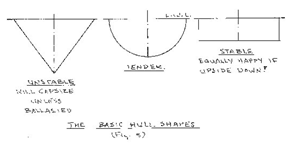
Light-displacement craft with overly generous beam may be almost as stable upside down as they are right side up, like Huck Finn’s raft. If they are rolled 180 degrees in extreme conditions of wind and sea, they may not right themselves, or they can right so slowly that the hull fills with water through hatches, vents, and other openings. When the boat eventually does right itself, it may well be in a dangerously swamped condition.
Bear in mind the Capsize Screening Formula: the maximum beam divided by the cube root of the displacement in pounds (Max. beam/Displ. pounds.333). If the result is greater than 2.0, the boat fails the test and may be considered unsafe for ocean voyaging. Multihulls, of course, do have tremendous form stability due to their extreme beam and are typical of vessels that are just as happy upside down as right side up. To offset this problem some sailing catamarans have floats or even inflatable bags at their mastheads so they cannot be knocked down much past a 90-degree angle.
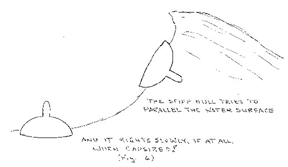
Heeling changes buoyancy
Though form stability increases with beam, yachts with the same beam can vary widely in form stability (see Fig. 7). The craft, with her maximum beam high up at deck level and narrowing gradually toward the waterline, will have less form stability than her equally beamy but wall-sided sister if the latter carries her full beam all the way down to the waterline. Similarly, given two yachts of equal waterline beam, the one with a U-shaped hull, having flat deadrise and hard bilges, will have greater form stability than her wineglass-shaped sister with deep deadrise and slack bilges. It all boils down to the fact that form stability depends on the shift of the heeled center of buoyancy, and the closer the vessel resembles a raft, the greater the shift of the CB as she heels.
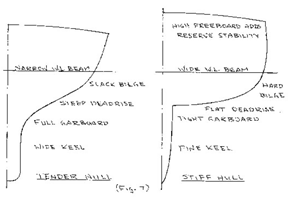
Factors that decrease form stability are soft bilges, deep deadrise angle, large-radius garboards joining the hull to the keel, a fine stern (double ender) and narrow beam. If these factors are not carried to excess, they may indicate a more comfortable vessel in a seaway . . . one with an easier motion. Many designers and owners believe that excess form stability is not desirable for serious offshore work; it can create a harsh, snappy motion that is hard on the crew and hard on the gear and rig and, as is evident, can be unsafe if carried to extremes.
Another point to consider in comparing section shape is “reserve” stability. This is the increasing stability picked up as the hull heels over to a decks-awash condition. Reasonably high freeboard is important to stability at higher heel angles because once the deck-edge is awash further heeling will move the CB inboard and shorten the righting arm. In open daysailers and powerboats, immersing the deck edge allows water to pour into the hull, where it remains on the low side and moves the CG to the low side or to leeward. This rapidly shortens the righting arm to the point where a capsize results if sail pressure is not relieved instantly Ñ as some readers may already have found to their dismay. I did! By getting the crew weight to windward, the righting arm is lengthened and stability increased.
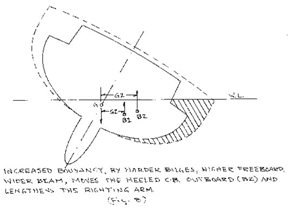
Hiking straps and trapezes are simply means of getting the weight even farther to windward and lengthening the righting arm even more. Having the deck-edge awash is not disastrous on a decked cruising yacht, of course. However, sailing with the deck awash does create considerable added resistance, and a few more inches of freeboard might well eliminate the problem. Indeed, high freeboard, if not carried to excess, can provide substantial added reserve stability (see Fig. 8). Flush-decked yachts usually benefit from this extra safety as they are generally given the highest freeboard of any normal type of vessel.
Moderation is good
In general, sailing yachts with moderate beam, moderate displacement, and ample ballast are safe vessels and, usually, good performers. Cruising sailboats have been designed with all-inside ballast, but this is unusual today except in replica types and shoal centerboarders such as the Cape Cod catboat.
Where maximum stability is desired, in order to increase the power to carry sail, the majority of the ballast should be in the keel, with only sufficient inside ballast for trimming purposes, perhaps 5 to 10 percent of the total. This trim ballast should be strapped down to prevent it from moving in case of a knockdown, of course. Ballast can be lead or iron, but lead is preferred for performance yachts as its greater density allows the weight to be concentrated lower. Bulb keels and wing keels also lower the ballast but, since these are generally associated with shoal-draft yachts, the stability is not necessarily increased. The amount of ballast will vary widely depending on the type and use of the yacht; the table (Fig. 9) is a very general guide.
|
Fig. 9
|
|
| Boat type Cape Cod catboat Motorsailer Keel/centerboard cruiser Keel cruiser-racer Heavy auxiliary cruiser 12 Meter yacht 5.5 Meter sloop Contemporary light, beamy cruiser |
Ballast ratio % 15-25 20-30 30-35 38-45 25-35 68-72 75-79 29-32
|
Obviously, the yachts with great form stability can perform well with a lower ballast ratio, at least until they get into extreme conditions. In any case, if you feel that your boat’s stability needs to be enhanced there is only one way to do it. You cannot change her hull shape (unless you are very wealthy or very handy) so the solution is weight; add ballast as low as possible, reduce weight aloft in the rig and on deck, get rid of that library of ponderous yachting tomes, and move weights such as heavy batteries, machinery, tanks, anchor chain, and so forth lower in the hull. You’ll be rewarded with added performance all around.
Article from Good Old Boat magazine, March/April 2000.


